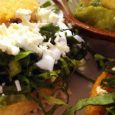
Machucado is a Mixe ritual dish cooked in a clay pot and shared in a circle. More than food, it is communion, fire, and living heritage.
Machucado is more than a traditional recipe; it is a communal act, a symbol of unity, and an ancestral offering in the mountains of Oaxaca. In the Mixe region — or ayuujk, as they call themselves — this dish is prepared not only with corn, chili peppers, and pumpkin seeds but is also shaped by history, identity, and ritual.
Although each Mixe community has its own culinary variations, machucado stands out as a sacred preparation that appears at key moments in the ritual calendar. And while its flavor captivates the palate, its true strength lies in the act of sharing it.
A culture woven with corn and mist
In the Sierra Norte of Oaxaca, the Mixes have cultivated a deep bond with the land and its cycles. Their gastronomy reflects this relationship: memelas, quelites, broths, and dried meats form a balanced and natural daily diet. But when it comes to ceremonies and important dates, food transforms into living offerings.
Machucado, known in the ayuujk language as mä’ätsy, appears precisely in this ritual context. It is not an ordinary meal nor prepared on any day. Its presence speaks of community, cooperation, and respect for the forces of nature.
What is machucado in Mixe gastronomy?
The base of machucado is cooked corn dough mixed with beans, flattened into memela shapes, and partially cooked on the griddle. Before finishing cooking, these memelas are removed from the fire and crushed — literally “machucado” — with hands or on the metate, in an act combining strength, skill, and heat. This is where its name comes from: mä’ätsy, meaning to gather or stir in Mixe.
Once crumbled, the dough is kneaded again and formed into a large ball placed in a hot clay pot set directly on the ground. Then a hot sauce made with chili and tomato or, in some versions, ground pumpkin seed, is poured over it. Upon contact with the red-hot clay, the mixture begins to bubble. The aroma is hypnotic.
Eating from the same dish: a ceremony of unity
The most important thing about machucado is not its flavor — although it is exquisite — but the way it is consumed. The pot is placed in the center, everyone sits around it, and eats with their hands, tearing small pieces of the dough to dip in the sauce. It is usually accompanied by cooked quelites, dried meat or fish, and chilacayotas. There are no individual plates or utensils. There is one fire, one container, one meal.
This way of eating is no accident. It represents communion among group members, equality before food, and recognition of shared work. Not everyone dares to put their hands in the hot clay, but all receive equally the fruit of that effort.
In some communities, there is a belief that whoever eats the last bite of machucado becomes the heir of the family. Therefore, finishing it is a good omen: it speaks of abundance, cohesion, and good fortune.
Machucado in the ritual calendar
Machucado is prepared on several key dates of the year, but in Santa María Tlahuitoltepec, one of the most recognized Mixe communities, there are two especially important moments: the closing of each community festival and August 1st, when the day of Lord Hunger is celebrated. On that date, families prepare machucado as an offering to invoke rain, fertility, and a good harvest.
There are also variations of the dish, such as potato machucado, where cooked potatoes are mixed with the dough before forming the ball. In all cases, the ritual and communal meaning remains intact.
In times of globalization and loss of traditions, machucado is a silent resistance that takes place among hills, mists, and metates. Through its preparation, the Mixes teach new generations not only to cook but to live in community, to respect corn, and to recognize that the most powerful food is not the one eaten alone but the one shared.
Machucado is not bought nor served on an individual plate. It is made collectively, eaten in a circle, and inherited with pride. It is, without a doubt, one of Mexico’s deepest culinary treasures.
